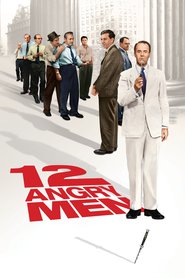
The American justice system is a Jury system based on the premise that all accused people shall be judged by their peers. In addition the system requires that all 12 members of a Jury are in agreement and that their decision is unanimous. The final important element of the system is that in order to declare a verdict of guilty, there must be an emphatic claim that there is no reasonable doubt. Poor defendants who can’t afford legal counsel are appointed a lawyer from the court. In many cases the court appointed lawyer is either inexperienced or incompetent.
Sydney Lumet’s outstanding premier film “12 Angry Men” assumes that Jurors can have the ability to overcome this incompetence and decipher the proper defense themselves. This is not exactly factual but is a vital part of the theme and storyline of the film. The movie is not a documentary which allows this liberty of not using some actual facts. This does not diminish the film however, as the movie is a powerful and riveting showcase of brilliant writing, outstanding acting and powerhouse directing.
An ethnic and poor young man has been accused of murdering his father and the film begins as the trial ends. From then on in, we are shown only one location set, that being the deliberation room of the 12 Jurors. Each Juror is a stranger to his peers and each is introduced as a number.
Juror #1 – The Juror foreman – High school football coach (Martin Balsam)
Juror #2 – Meek and small bank worker (John Fiedler)
Juror #3 – Bitter and angry businessman (Lee J. Cobb)
Juror #4 – Cold and intelligent stock broker concerned only with the facts (E.G. Marshall)
Juror #5 – The man who came from a poor background (Jack Klugman)
Juror #6 – Respectful and principled house painter (Edward Binns)
Juror #7 – Selfish and shallow salesman (Jack Warden)
Juror #8 – Intelligent and thoughtful architect (Henry Fonda)
Juror # 9 – Slow and thoughtful pensioner (Joseph Sweeney)
Juror # 10 – Loud mouth Bigot garage owner (Ed Begley)
Juror # 11 – While not specified directly, probably Jewish Naturalized European watchmaker (George Voskovec)
Juror # 12 – Wisecracking always joking advertising executive (Robert Webber)
All of the actors are first rate and the movie is rightfully considered one of the greatest pieces of ensemble acting ever made. Fonda as the Juror who causes the conflict and tension in the film is perfect for the role of the strong minded, kind and intelligent architect. Sweeney portrays the old man in a pitch perfect way as to allow us, the viewer, to view him differently as the film proceeds and based on his slow but thoughtful actions. Ed Begley is spot on loathsome as the Bigot and Lee J. Cobb is again outstanding in bringing out the complexities of his tortured character. The rest are also very good.
The story revolves around Juror 8’s (Fonda) demand that they go over the trial facts and findings before they make up their minds. The film takes place in the middle of a blistering heat wave and the deliberation room has no air conditioning. The uncomfortable conditions add to the pressure and tension placed upon the group.
The screenplay was based on a teleplay by Reginald Rose and he adapted it for the screen without much modifications as other than the starting scenes of exiting the court and the ending scene of entering the court, the entire film takes place in the one deliberating room. Rose brings to life all of the various people and makes sure that their separate backgrounds and personalities are realistically shown allowing for a textured and complex set of interactions between the characters. The script also allows us to compare how two separate characters behave differently when outnumbered. Prejudices and fears effect who we are and how we behave as humans and no film shows this better then, this one.
Why the men are considered angry as per the film title is an interesting question. They are not angry at the accused in the trial nor do they seem to be upset about the victim or the crime itself. Their anger is shown through their interactions with each other. The clashes of various backgrounds and mentalities causes anger through the deliberations and it is this anger that gives the film its meat.
The director is the great Sydney Lumet and what was his first film. Fonda who championed the film, handpicked Lumet because of Lumet’s previous experience in directing television drama. The thinking was to film the movie like a teleplay. Lumet had other ideas. His style of filming is one of the great and thrilling aspects of the film. At the beginning of the movie he films the group by placing the camera at eye level emphasizing their strangeness and distance to each other. As the fascinating deliberations continue he would film the group from above so as to close in on them and tighten their connection to each other. By the riveting conclusion he is filming each protagonist from below and in close-up to emphasize each personality and reaction and causing a feeling of claustrophobia. When we talk about great American directors such as Scorsese and Coppola, rarely does the name Lumet get mentioned, which is a great shame because he was a socially conscience director who used ingenious and stylish methods of getting his message across.
The combination of his stylish filming and the brilliant script along with wonderful acting makes, “12 Angry Men”, the greatest film made about American Law and one of the greatest American films ever made.

